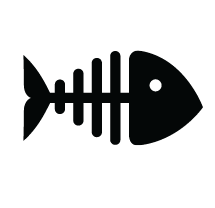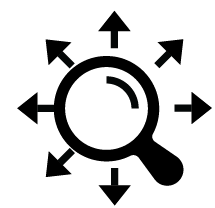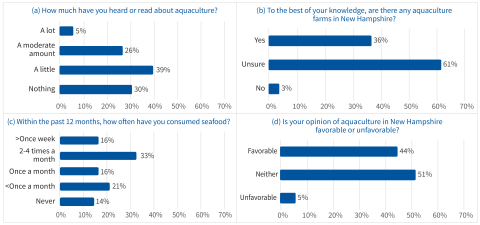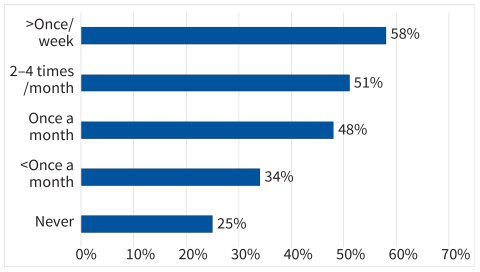Key Findings





Aquaculture in New Hampshire: An Evolving Landscape
Over the past decade, aquaculture—the farming and cultivation of aquatic species—has experienced significant growth globally and in the U.S. Northeast to meet market demands for seafood.1 Growth of this sector depends on a combination of factors, with public perceptions playing a key role. Aquaculture is considered a sustainable method of seafood production and can provide both economic and environmental benefits to coastal environments and communities.2 In the state of New Hampshire, a small but growing aquaculture industry has emerged, primarily focused on cultivated oysters in Little Bay and Hampton-Seabrook Estuary.3 In fact, oyster aquaculture is the fastest growing seafood industry in the state,4 providing sustainable food and environmental benefits to coastal communities.
Yet despite ongoing and growing investments in technological and biological research to advance sustainable aquaculture production, challenges remain. One such challenge is related to public willingness to consume aquaculture products as well as acceptance of farm siting in communities. Most aquaculture farms currently operate in coastal waters which are common-pool resources and require a federal, state, or municipality-issued lease agreement to operate. Likewise, proposals for land-based aquaculture operations typically require permits that must be approved through municipal boards. Because of this, community members are key parties and play a significant role in industry outcomes. Thus, how the public feels about aquaculture development matters. Currently in New Hampshire, little is known about residents’ perceptions of aquaculture outside anecdotal stories, exposing a gap in knowledge that has implications for the future of the industry. Although research conducted elsewhere shows that public sentiment is more favorable among people who eat seafood more often and among those who are more familiar with aquaculture, it is not yet known whether those relationships hold true in New Hampshire.5
Understanding Aquaculture Perceptions in the Granite State
To understand perceptions of aquaculture, the University of New Hampshire’s Survey Center conducted a representative statewide survey of New Hampshire residents in June 2024 on behalf of New Hampshire Sea Grant. In part, participants were asked to note how much they had heard or read about aquaculture, and their knowledge of aquaculture farms in New Hampshire.
As presented in Figure 1, a majority of New Hampshire respondents (65 percent) had read or heard at least a moderate amount about aquaculture. Only 5 percent of New Hampshire residents said they had heard or read a lot about aquaculture, while 30 percent of respondents said they had read or heard nothing about aquaculture. A majority of respondents (61 percent) were unsure if there was aquaculture in New Hampshire, and only 36 percent of New Hampshire residents responded correctly that there is aquaculture in the Granite State. When asked if New Hampshire had any shellfish or finfish aquaculture, the same pattern remained. In fact, residents were more unsure that there was shellfish aquaculture in New Hampshire (73 percent) than they were of general aquaculture, even though shellfish is the overwhelming majority of farms in the state.

Note. Descriptive results from questions gauging familiarity with aquaculture (1a: n=1,199), knowledge of aquaculture in New Hampshire (1b: n=1,191), consumption of seafood (1c: n=1,196) and sentiment of aquaculture in New Hampshire (1d: n=1,202). Source: New Hampshire Granite State Poll, June 2024.
Participants were also asked to respond with how often they consumed seafood within the past 12 months to understand how this factor might influence their views, demonstrated in Figure 1c. The most common response (33 percent) was that respondents had consumed seafood an average of 2–4 times per month, while 21 percent consumed seafood less than once a month. Only 14 percent of New Hampshire residents never consumed seafood within the past 12 months, while 16 percent said they consumed seafood more than once a week.
Lastly, participants were asked whether their opinion about aquaculture in New Hampshire was favorable or unfavorable on a 5-point scale. Just over half (51 percent) of respondents had no opinion regarding favorability of aquaculture, while 44 percent were somewhat or very favorable. Only 5 percent felt either somewhat or very unfavorable of aquaculture.
Effects of Familiarity, Knowledge, and Seafood Consumption on Favorable Public Sentiment of Aquaculture
To investigate how familiarity and knowledge affect public sentiment in New Hampshire, we used regression modeling. Results demonstrated that how much a respondent has read or heard about aquaculture, whether they are aware that there is aquaculture activity in New Hampshire, and frequency of seafood consumption are all significant predictors of aquaculture sentiment, even after accounting for differences based on social characteristics. Figure 2 visualizes the relationship between how often New Hampshire residents had heard or read about aquaculture and aquaculture sentiment. Eighty-three percent of those who had heard or read “a lot” about aquaculture also felt somewhat or very favorable compared to only 17 percent who had heard or read “nothing” about aquaculture. Clearly, there is a strong, positive relationship between familiarity with aquaculture and positive sentiment among New Hampshire residents.

Note. Weighted percent of respondents who feel somewhat or very favorable about aquaculture by how much they have read or heard about aquaculture, p<0.001, (n=1,199). Source: New Hampshire Granite State Poll, June 2024.
Similarly, we found that knowledge of aquaculture activity in New Hampshire is also linked to New Hampshire residents’ favorability of aquaculture, even after accounting for how much respondents have read or heard. As shown in Figure 3, those aware of aquaculture in New Hampshire were more likely to hold somewhat or very favorable views (66 percent) than those who were unsure or said that there was no aquaculture in the state (33 percent). Since there is aquaculture activity in New Hampshire, “don’t know” and “no” were combined, though analysis with the original three categories offered similar conclusions: knowledge of aquaculture in New Hampshire is positively associated with sentiment.

Note. Weighted percent of respondents who feel somewhat or very favorable about aquaculture by whether they know that there is aquaculture activity, p<.01, (n=1,191). Source: New Hampshire Granite State Poll, June 2024.
Lastly, survey results reveal a relationship between frequency of seafood consumption and how respondents feel about aquaculture. As shown in Figure 4, over half of respondents (58 percent) who consumed seafood more than once a week during the past year felt somewhat or very favorable about aquaculture. On the other hand, only one-quarter of respondents who never consumed seafood were favorable to aquaculture. Interestingly, this relationship is even more pronounced when looking more specifically at frequency of consumption at home. In both cases, more frequent consumption of seafood is strongly linked to positive aquaculture sentiment.

Note. Weighted percent of respondents who feel somewhat or very favorable about aquaculture by frequency of seafood consumption, p<0.05, (n=1,196). Source: New Hampshire Granite State Poll, June 2024.
Next Steps: Policy Implications for New Hampshire
Global, national, and regional trends all point to the growing role aquaculture will play in the coming years in meeting demand for seafood products.6 It is essential that the industry’s development unfolds in a way that is environmentally, economically, and socially beneficial to the surrounding communities. The findings in this study underscore a unique educational and community engagement opportunity in New Hampshire given the relatively low familiarity with aquaculture yet strong link between favorability, awareness, and seafood consumption.
We found that positive perceptions of aquaculture are significantly related to familiarity and knowledge of aquaculture. We also found that one of the most important predictors of positive perceptions of aquaculture is how frequently respondents eat seafood. Considering most New Hampshire residents are unfamiliar with aquaculture, these findings have important implications for the future of the industry and underscore the importance of education and exposure to aquaculture products through seafood consumption.
Taken in concert with other unique characteristics of New Hampshire residents (for example the state ranks sixth in the nation for rates of attending public meetings and seventh for “talking about important political, societal, or local issues with friends and family”7), the results of this survey provide new ways to think about aquaculture education and community participation. Strengthening aquaculture literacy can help build the confidence necessary for the public to engage meaningfully in conversations about aquaculture planning and development.8 Continued, socially sustainable growth of the industry will require an engaged and informed public. These findings indicate opportunities for industry members, regulatory agencies, researchers, and other partners to work together to develop approaches to build two-way dialogs to increase public familiarity with this important sector within New Hampshire’s coastal economy.
Methods
The June 2024 Granite State Poll, conducted by the University of New Hampshire Survey Center, was a web-based survey of Granite State Panel Members who are recruited by calling a random sample of cellular and landline phones, texting a random sample of phones, and mailing a random sample of New Hampshire addresses, and only included New Hampshire residents over the age of 18. After an invitation email was sent to Granite State Panel members on June 13th, 2024, the survey concluded with 1,202 responses. Data was weighted by respondent sex, age, education, and region of the state to target the most recent American Community Survey conducted by the Census Bureau, and was also weighted by party registration levels. New Hampshire Sea Grant included five questions about aquaculture in the survey that explored familiarity with aquaculture, knowledge of aquaculture in New Hampshire, frequency of seafood consumption, and public sentiment.
Endnotes
1. NOAA. 2024. “Aquaculture.” National Oceanic and Atmospheric Administration. Retrieved August 1, 2024. https://www.fisheries.noaa.gov/topic/aquaculture.
FAO. 2022. “The State of World Fisheries and Aquaculture 2022: Towards Blue Transformation.” Food and Agriculture Organization of the United Nations. Rome.
2. Gentry, Rebecca, Halley Froehlich, Dietmar Grimm, Peter Kareiva, Michael Parke, Michael Rust, Steven Gaines, and Benjamin Halpern. 2017. “Mapping the global potential for marine aquaculture.” Nature Ecology and Evolution. 1 (2017): 1317–1324.
Grebe, Gretchen, Carrie Byron, Adam St. Gelais, Dawn Kotowicz, and Tollef Olson. 2019. “An ecosystem approach to kelp aquaculture in the Americas and Europe.” Aquaculture Reports. 15: 100215.
Grebe, G.S., C.J. Byron, D.C. Brady, A.H. Geisser, and K.D. Brennan. 2021. “The nitrogen bioextraction potential of nearshore Saccharina latissima cultivation and harvest in the Western Gulf of Maine.” Journal of Applied Phycology. 33 (2021): 1741–1757.
Hilborn, Ray, Jeannette Banobi, Stephen Hall, Teresa Pucylowski, and Timothy Walsworth. 2018. “The environmental cost of animal source foods.” Frontiers in Ecology and the Environment. 16(6): 329–335.
Kim, Jang, Charles Yarish, Eun Kyoung Hwang, Mison Park, and Youngdae Kim. 207. “Seaweed aquaculture: cultivation technologies, challenges and its ecosystem services.” Algae. 32(1):1–13.
3. New Hampshire Sea Grant. 2023. “Oysters.” New Hampshire Sea Grant. https://seagrant.unh.edu/our-work/aquaculture/oysters
4. Ibid.
5. Barrington, Kelly, Neil Ridler, Thierry Chopin, Shawn Robinson, and Bryn Robinson. 2008. “Social Aspects of the Sustainability of Integrated Multi-Trophic Aquaculture.” Aquaculture International. 18:201–211.
Bouchard, D., M.E Camire, C. Davis, G. Shaler, R. Dumont, R. Bernier, and R. Labbe. 2021. “Attitudes toward aquaculture and seafood purchasing preferences: evidence from a consumer survey of Atlantic states.” Aquaculture Economics and Management. 25(4):411–429. DOI: 10.1080/13657305.2020.1869859.
Kaiser, M., and S.M. Stead. 2002. “Uncertainties and values in European aquaculture: communication, management and policy issues in times of “changing public perceptions.” Aquac Int. 10:469–490.
Murrary, M., J. R. Anthony, C.L. Noblet, and L. Rickard. 2017. “2017 National Aquaculture Survey Results.” The University of Maine: Sustainable Ecological Aquaculture Network (SEANET). Retrieved from: https://umaine.edu/epscor/wp-content/uploads/sites/25/2018/01/Tech-Report-Final.pdf.
NOAA. 2022. “Aquaculture Literacy at NOAA”. www.fisheries.noaa.gov/national/aquaculture/aquaculture-literacy-noaa.
Robertson, R., E. Carlsen, and A. Bright. 2002. “Effect of Information on Attitudes Towards Offshore Marine Finfish Aquaculture Development in Northern New England.” Aquaculture Economics and Management, 6(1/2): 117–126.
Thomas, J.B., J. Nordstrom, E. Risen, M. Malmstrom, and F. Grondahl. 2018. “The Perception of Aquaculture on the Swedish West Coast.” AMBIO. 47:398–409.
Whitmore, Emily, Thomas Safford, and Lawrence Hamilton. 2022. “What Does the Public Think about Farming Seafood? Modeling Predictors of Social Support for Aquaculture Development in the U.S.” Ocean and Coastal Management. 226 (4):106279. 10.1016/j.ocecoaman.2022.106279.
6. Mair, Graham Charles, et al. 2023. “A Decadal Outlook for Global Aquaculture." Journal of the World Aquaculture Society, volume 54. P. 196–205. https://doi.org/10.1111/jwas.12977
NOAA. “NOAA Aquaculture Strategic Plan” (2023–2028). 2022. NOAA. https://www.fisheries.noaa.gov/resource/document/noaa-aquaculture-strategic-plan-2023-2028.
7. Moore-Vissing, Quixada, and Bruce Mallory. 2020. “2020 New Hampshire Civic Health Index.” https://carsey.unh.edu/what-new-hampshire/additional-reports/2020-new-hampshire-civic-health-index.
8. NOAA. 2022. “Aquaculture Literacy at NOAA.” https://www.fisheries.noaa.gov/national/aquaculture/aquaculture-literacy-noaa.
About the Authors
- Anna Maccaroni is a student at the University of New Hampshire studying sociology, sustainability, and survey research.
- Emily Whitmore is the social science research manager at the Maine Aquaculture Innovation Center where she focuses on the social dimensions of aquaculture development and works to develop guidance for farmers on how to work with communities.
- Lindsey Williams is an Associate Director at New Hampshire Sea Grant where she focuses on workforce development and the applied use of social science research to inform decision making about ocean and coastal resource management.
Acknowledgements
Support for this project was provided by New Hampshire Sea Grant via National Oceanic and Atmospheric Administration Award No. NA22OAR4170124. Any opinions, findings, and conclusions or recommendations expressed in this material are those of the authors and do not necessarily reflect the views of funders. The work was substantially completed as part of the New Hampshire Sea Grant Doyle Undergraduate Marine Extension Fellowship. The authors would also like to acknowledge Dr. Linas Kenter for his participation in developing the survey questions, the NH Sea Grant Sustainable Fisheries and Aquaculture focus area team for their encouragement, and the UNH Survey Center staff for all their support.
Copyright 2024. Carsey School of Public Policy. These materials may be used for the purposes of research, teaching, and private study. For all other uses, contact the copyright holder.
